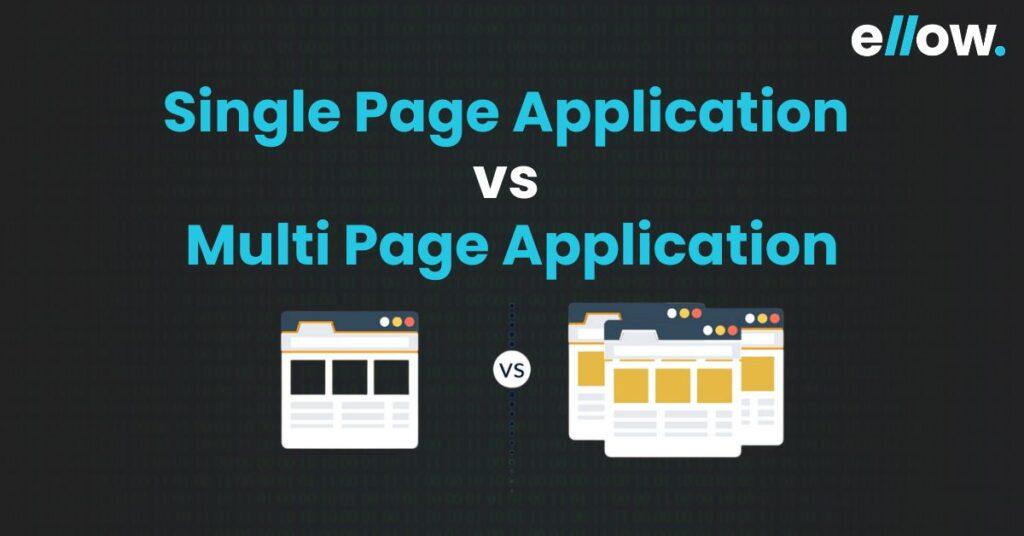
Let’s build the future together.
Great ideas need great people. Partner with us to bring your vision to life, or take the first step in your career by joining our team of innovators.

The path to creating a successful web application requires careful consideration of the technology stack and architecture that we choose. In web development, an age-old debate revolves around single-page applications (SPAs) versus multi-page applications (MPAs). With so many opinions, it can be tricky to figure out what’s best for your web development.
We will take a look at what SPAs and MPAs are, their advantages and disadvantages, and their key attributes. We will also see real-world scenarios where SPAs or MPAs excel, ensuring that we are armed with the knowledge needed to choose between SPA and MPA.
The two popular approaches that stand out in web application development are Single Page Applications (SPA) and Multi-Page Applications (MPA). Both have their strengths and weaknesses and understanding the differences between them can help us make informed choices.
A single-page application (SPA) is a modern way to build apps, like the ones Google, Facebook, Twitter, and others use. SPAs are like apps that run in our web browser, and they don’t need to reload the whole page when we use them.
A multiple-page application (MPA) is a more traditional approach to app development. With MPAs, every time we want to see something new, the whole web page has to reload. E-commerce companies with lots of products often prefer this approach.
We will explore the differences like speed, coupling, search engine optimization (SEO), user experience, security, development process, and JavaScript dependency in greater detail.
Sign up with ellow, access 25,000+ pre-vetted developer profiles, and start building your development team in 48 hours.
A single-page application is a web app that operates within a web browser without the need for page reloading while in use.
SPAs deliver an exceptional user experience by giving us a smooth, “natural” browsing environment without any interruptions. They consist of a single webpage that loads all content through JavaScript, depending heavily on advanced frameworks like AngularJS, Ember.js, Meteor.js, and Knockout.js. SPAs independently fetch markup and data, rendering pages directly in the browser.
These sites maintain users within a single, user-friendly web space, presenting content straightforwardly and efficiently, and ensuring a comfortable and cohesive experience.
In 2022 according to Statista, JavaScript and HTML/CSS stood out as the prevailing programming languages in the global software developer community. Approximately 63.6 percent of respondents reported using JavaScript, while roughly 53 percent utilized HTML/CSS.
Every day thousands of users use Single-Page Applications without even realizing it. Some of the popular examples include Facebook, Twitter, Gmail, Google Maps, and Google Drive. These applications use JavaScript to load the content and update and change it as one navigates.
Single Page Applications come with several advantages that make them a popular choice for web development:
However, SPAs also have some drawbacks:
Single-page applications offer speed, user-friendliness, offline capabilities, and development efficiency but come with trade-offs like initial loading time and SEO limitations.
Sign up with ellow, and access 25,000+ pre-vetted developer profiles, and start building your development team in 48 hours.
A Multi-Page Application, or MPA, is a type of website or web application where each page is separately created and sent to our web browser by a server.
Unlike Single Page Applications (SPAs), which build pages in our browser using JavaScript, MPAs depend on the server to generate and refresh pages. This means that every time a user interacts with an MPA, for example, clicking a link or submitting a form, the server sends a new page to the browser.
In a Multi-Page Application, when there is an action like clicking on a link or submitting a form, the server creates a new page with the updated content and sends it to our browser. This constant communication with the server is necessary to ensure that we see the most up-to-date information on each page.
Multi-page applications are commonly used for e-commerce websites, including online marketplaces and product catalogs. When a website or app needs to make significant changes as you move from one page to another, developers often opt for the MPA approach. So, when shopping for Christmas gifts on Amazon or searching for a vintage record player on eBay, we are using an MPA.
Now, let’s explore the advantages and disadvantages of Multi-Page Applications.
Multi-page applications offer benefits like SEO optimization, scalability, and robust analytic capabilities. However, they come with drawbacks such as potential performance issues and increased hosting costs.
When choosing between Single-Page Applications (SPA) and Multi-Page Applications (MPA) for a website or app creation, there are several key factors. Let us explore these factors to help us make a decision.
Users have little patience for waiting in today’s digital fast paced world while browsing, and Single Page Applications (SPAs) offer a notable advantage in this regard.. They load quickly because they fetch most of the app resources just once. This means when a user requests new data, the entire page doesn’t reload.
On the other hand, MPAs tend to be slower. Why? Because every time you want to see something new or move to a different part of the website, the browser reloads the whole page from scratch. The optimal loading time for a website is 0.4 seconds, and if a website is heavy on images, choosing an SPA might be a better choice for speed.
SPA and MPA have different approaches to coupling. SPAs are strongly decoupled, which means the front-end and back-end are separate entities. In SPAs, the front end uses APIs developed by server-side developers to read and display data. In contrast, MPAs are more interdependent, with both front-end and back-end often housed under one project.
SEO is crucial for visibility on the web and search engines. Unfortunately, SPAs have a weakness in this area. Most single-page applications run on JavaScript, which many search engines don’t fully support. Search engines typically index web pages by “crawling” or “spidering” through HTML files, making static HTML pages easier to rank.
MPAs, however, have an advantage when it comes to SEO. Each page can be optimized for different keywords, and meta tags can be added to every page, which positively impacts rankings on search engines like Google.
User experience is a top priority nowadays. SPAs excel in mobile-friendliness, which is essential as a significant amount of traffic comes from mobile devices. The mobile experience is so critical that even Google prioritizes it over the desktop experience. The frameworks used in SPA development enable the creation of mobile apps.
MPAs, on the other hand, shine in information architecture. You can create numerous pages and include as much information as needed without limitations. Clear navigation in MPAs makes it easy for users to find their way around, enhancing their overall experience.
Bigger websites often mean more security challenges, especially for multi-page applications. If an MPA is opted, there is a need to secure each web page individually. In SPAs, securing data endpoints is crucial but slightly different. SPAs are more vulnerable to hacker attacks because they rely on JavaScript, which doesn’t perform code compilation, making it susceptible to malware.
SPA’s reusable backend code is a significant advantage. Reusing code means less work, and the same code can be used for both the web and mobile apps. This is important because most users access applications and websites on their mobile devices.
There is a clear separation between front-end and back-end in SPAs, both parts can be developed simultaneously, speeding up the overall development process. In contrast, MPAs often require coding the server side from scratch, which can extend the development timeline.
SPAs heavily rely on JavaScript, which can present challenges. While more search engines are starting to support JavaScript, the level of support varies depending on the JavaScript framework used. If a user disables JavaScript in their browser, it can lead to functionality issues, higher bounce rates, and lower conversion rates. JavaScript dependency also contributes to SEO and security concerns. But MPAs can be built without any JavaScript dependency.
In the present day, nearly every type of device, including Windows, Linux, macOS, Android, iOS, and smart TVs, extensively relies on the most widely adopted JavaScript frameworks. As of 2022 according to Radixweb, within the 1.8 billion websites across the globe, an astounding 98% employ JavaScript as their preferred client-side programming language, underscoring its remarkable surge in popularity.
When deciding between a Single Page Application (SPA) and a Multi Page Application (MPA), there are some key considerations to consider.
When it comes to deciding between single-page apps (SPAs) and multi-page apps (MPAs) for web development, it’s important to take a thorough approach. This means we need to consider two key factors: the advantages and drawbacks of each architecture and the specific needs of our web application.
To make the right choice, it’s often valuable to consult with experts and collaborate with a highly skilled software development team who can provide valuable insights and guidance and Ellow’s global talent pool of 25,000+ vetted developers will give you access to a diverse range of skills and expertise to meet your specific project needs and drive innovation in your organization.
Sign up with ellow, and access 25,000+ pre-vetted developer profiles, and start building your development team in 48 hours.
A single-page app loads everything we need from the server once and doesn’t reload the page with each click. Multi-page apps, on the other hand, fetch a new page from the server for each change, causing full-page reloads and resource downloads.
Multi-page apps are preferable for two reasons: They’re more SEO-friendly than single-page apps, and they tend to be more scalable.
Single-page apps minimize data transfer between the server and client, resulting in faster load times. Additionally, they decouple server-side code from the UI for efficient development.
Great ideas need great people. Partner with us to bring your vision to life, or take the first step in your career by joining our team of innovators.
Looking to build your career in development? team@ellow.io